- Home
- Kurt Vonnegut
Bluebeard Page 7
Bluebeard Read online
Page 7
What kept him from coming anywhere near to greatness, although no more marvelous technician ever lived? I have thought hard about this, and any answer I give refers to me, too. I was the best technician by far among the Abstract Expressionists, but I never amounted to a hill of beans, either, and couldn't have--and I am not talking about my fiascoes with Sateen Dura-Luxe. I had painted plenty of pictures before Sateen Dura-Luxe, and quite a few afterwards, but they were no damned good.
But let's forget me for the moment, and focus on the works of Gregory. They were truthful about material things, but they lied about time. He celebrated moments, anything from a child's first meeting with a department store Santa Claus to the victory of a gladiator at the Circus Maximus, from the driving of the golden spike which completed a transcontinental railroad to a man's going on his knees to ask a woman to marry him. But he lacked the guts or the wisdom, or maybe just the talent, to indicate somehow that time was liquid, that one moment was no more important than any other, and that all moments quickly run away.
Let me put it another way: Dan Gregory was a taxidermist. He stuffed and mounted and varnished and mothproofed supposedly great moments, all of which turn out to be depressing dust-catchers, like a moosehead bought at a country auction or a sailfish on the wall of a dentist's waiting room.
Clear?
Let me put it yet another way: life, by definition, is never still. Where is it going? From birth to death, with no stops on the way. Even a picture of a bowl of pears on a checkered tablecloth is liquid, if laid on canvas by the brush of a master. Yes, and by some miracle I was surely never able to achieve as a painter, nor was Dan Gregory, but which was achieved by the best of the Abstract Expressionists, in the paintings which have greatness birth and death are always there.
Birth and death were even on that old piece of beaverboard Terry Kitchen sprayed at seeming random so long ago. I don't know how he got them in there, and neither did he.
I sigh. "Ah, me," says old Rabo Karabekian.
10
BACK IN 1933:
I told a policeman in Grand Central Station Dan Gregory's address. He said it was only eight blocks away, and that I couldn't get lost, since that part of the city was as simple as a checkerboard. The Great Depression was going on, so that the station and the streets teemed with homeless people, just as they do today. The newspapers were full of stories of worker layoffs and farm foreclosures and bank failures, just as they are today. All that has changed, in my opinion, is that, thanks to television, we can hide a Great Depression. We may even be hiding a Third World War.
So it was an easy walk, and I soon found myself standing in front of a noble oak door which my new master had used on the cover of the Christmas issue of Liberty magazine. The massive iron hinges were rusty. Nobody could counterfeit rust and rust-stained oak like Dan Gregory. The knocker was in the shape of a Gorgon's head, with intertwined asps forming her necklace and hair.
If you looked directly at a Gorgon, supposedly, you were turned to stone. I told that today to the kids around my swimming pool. They had never heard of a Gorgon. I don't think they've heard of anything that wasn't on TV less than a week ago.
On the Liberty cover, as in real life, the lines in the Gorgon's malevolent face and the creases between the writhing asps were infected with verdigris. Nobody could counterfeit verdigris like Dan Gregory. There was a holly wreath around the knocker on the cover, which had been taken down by the time I got there. Some of the leaves had been brown around the edges or spotted. Nobody could counterfeit plant diseases like Dan Gregory.
So I lifted the Gorgon's heavy necklace and let it fall. The boom reverberated in an entrance hall whose chandelier and spiral staircase would also be old stuff to me. I had seen them in an illustration of a story about a fabulously rich girl who fell in love with her family's chauffeur: in Collier's, I believe.
The face of the man who answered my boom was also well known to me, if not his name, since he had been a model for many of Gregory's pictures--including one about a rich girl and her chauffeur. He had been the chauffeur, who in the story would save the girl's father's business after everybody but the girl scorned him as being nothing but a chauffeur. That story, incidentally, was made into the movie You're Fired, the second movie to star sound as well as images. The first one was The Jazz Singer, starring Al Jolson, who was a friend of Dan Gregory until they had a falling out about Mussolini during my first night there.
The man who opened the door to me had a very good face for an American-style hero, and had in fact been an aviator during the First World War. He was truly Gregory's assistant, what Marilee Kemp had only claimed to be, and would become the only friend who stuck with Gregory to the bitter end. He, too, would be shot while wearing an Italian uniform in Egypt during not his First but his Second World War.
So says this one-eyed Armenian fortune-teller as he peers into his crystal ball.
"Can I help you?" he said. There wasn't a flicker of recognition in his eyes, although he knew who I was and that I would be coming to the house at any time. He and Gregory had resolved to give me a chilly welcome. I can only guess at their deliberations prior to my arrival, but they must have been along the lines of my being a parasite which Marilee had brought into the house, a thief who had already stolen hundreds of dollars' worth of art materials.
They must have persuaded themselves, too, that Marilee was wholly to blame for her backward somersaults down the studio staircase, and that she had unjustly blamed Gregory. As I say, I myself would believe that until she told me the truth of the matter after the war.
So, just to start somewhere in proving that I was right to be on the doorstep, I asked for Marilee.
"She's in the hospital," he said, still barring the way.
"Oh," I said. "I'm sorry." And I told him my name.
"That's what I figured," he said. But still he wasn't going to ask me in.
So then Gregory, who was about halfway down the spiral staircase, asked him who was at the door, and the man, whose name was Fred Jones, said, as though "apprentice" were another name for tapeworm, "It's your apprentice."
"My what?" said Gregory.
"Your apprentice," said Jones.
And Gregory now addressed a problem I myself had pondered: what was a painter's apprentice supposed to do in modern times, when paints and brushes and so on no longer had to be made right in the painter's workplace?
He said this: "I need an apprentice about as much as I need a squire or a troubadour."
His accent wasn't Armenian or Russian--or American. It was British upper class. If he had so chosen, up there on the spiral staircase, looking at Fred Jones, not at me, he might have sounded like a movie gangster or cowboy, or a German or Irish or Italian or Swedish immigrant, and who knows what else? Nobody could counterfeit more accents from stage, screen and radio than Dan Gregory.
That was only the beginning of the hazing they had planned so lovingly. This was in the late afternoon, and Gregory went back upstairs without greeting me, and Fred Jones took me down into the basement, where I was served a supper of cold leftovers in the servants' dining room off the kitchen.
That room was actually a pleasant one, furnished with early American antiques which Gregory had used in illustrations. I remembered the long table and the corner cupboard full of pewter and the rustic fireplace with a blunderbuss resting on pegs driven into its chimney breast, from a painting he had done of Thanksgiving at Plymouth Colony.
I was put at one end of the table, with my silverware thrown down any which way, and no napkin. I still remember no napkin. While at the other end five places were very nicely set, with linen napkins and crystal and fine china and neatly deployed silverware, and with a candelabrum at their center. The servants were going to have a fine dinner party to which the apprentice was not invited. I was not to consider myself one of them.
Nor did any of the servants speak to me. I might as well have been a bum off the street. Fred Jones moreover stood over me whi
le I ate--like a sullen prison guard.
While I was eating, and more lonesome than I had ever been in my life, a Chinese laundryman, Sam Wu, came in with clean shirts for Gregory. Pow! A flash of recognition went off in my skull. I knew him! And he must know me! Only days later would I realize why I thought I knew Sam Wu, although he certainly didn't know me. All dressed up in silk robes and wearing a skullcap, this simperingly polite laundryman had been the model for Dan Gregory's pictures of one of the most sinister characters in all of fiction, the Yellow Menace personified, the master criminal Fu Manchu!
Sam Wu would eventually become Dan Gregory's cook, and then go back to being a laundryman again. And he would be the person to whom I sent the paintings I bought in France during the war.
It was a curious and touching relationship we had during the war. I happened to run into Sam in New York City just before I went overseas, and he asked for my address. He had heard on the radio, he said, about how lonesome soldiers could be overseas, and that people should write to them often. He said I was the only soldier he knew well, so he would write to me.
It became a joke in our platoon at mail call. People would say to me things like: "What's the latest news from Chinatown?" or "No letter from Sam Wu this week? Maybe somebody poisoned his chow mein," and so on.
After I got my pictures from him after the war, I never heard from him again. He may not even have liked me much. For him, I was strictly a wartime activity.
Back to 1933:
Since supper was so nasty, I would not have been surprised to be escorted next to a windowless room by the furnace, and told that that was to be my bedroom. But I was led up three flights of stairs to the most sumptuous chamber any Karabekian had ever occupied, and told to wait there until Gregory had time to see me, which would be in about six hours, at about midnight, Fred Jones estimated. Gregory was giving a dinner party in the dining room right below me for, among others, Al Jolson and the comedian W. C. Fields, and the author whose stories Gregory had illustrated countless times, Booth Tarkington. I would never meet any of them because they would never come back to the house again--after a bitter argument with Gregory about Benito Mussolini.
About this room Jones put me in: It was Dan Gregory's counterfeit, with genuine French antiques, of the bedroom of Napoleon's Empress Josephine. The chamber was a guest room and not Gregory's and Marilee's bedroom. Imprisoning me there for six hours was subtle sadism of a high order indeed. For one thing, Jones, with a perfectly straight face, indicated that this was to be my bedroom during my apprenticeship, as though anybody but a person as lowborn as myself would find it a perfectly ordinary place to sleep. For another: I didn't dare touch anything. Just to be sure I didn't, Jones said to me, "Please be as quiet as possible, and don't touch anything."
One might have thought they were trying to get rid of me.
I have just given this snap quiz to Celeste and her friends out by the tennis courts: "Identify the following persons in history: 'W. C. Fields, the Empress Josephine, Booth Tarkington, and Al Jolson.'"
The only one they got was W. C. Fields, whose old movies are shown on TV.
And I say I never met Fields, but that first night I tiptoed out of my gilded cage and to the top of the spiral staircase to listen to the arrival of the famous guests. I heard the unmistakable bandsaw twang of Fields as he introduced the woman with him to Gregory with these words: "This, my child, is Dan Gregory, the love child of Leonardo da Vinci's sister and a sawed-off Arapahoe."
I complained to Slazinger and Mrs. Berman at supper last night that the young people of today seemed to be trying to get through life with as little information as possible. "They don't even know anything about the Vietnam War or the Empress Josephine, or what a Gorgon is," I said.
Mrs. Berman defended them. She said that it was a little late for them to do anything about the Vietnam War, and that they had more interesting ways of learning about vanity and the power of sex than studying a woman who had lived in another country one hundred and seventy-five years ago. "All that anybody needs to know about a Gorgon," she said, "is that there is no such thing."
Slazinger, who still believes her to be only semiliterate, patronized her most daintily with these words: "As the philosopher George Santayana said, 'Those who cannot remember the past are condemned to repeat it.'"
"Is that a fact?" she said. "Well--I've got news for Mr. Santayana: we're doomed to repeat the past no matter what. That's what it is to be alive. It's pretty dense kids who haven't figured that out by the time they're ten.
"Santayana was a famous philosopher at Harvard," said Slazinger, a Harvard man.
And Mrs. Berman said, "Most kids can't afford to go to Harvard to be misinformed."
I happened to see in The New York Times the other day a picture of a French Empire escritoire which was auctioned off to a Kuwaiti for three quarters of a million dollars, and I am almost certain it was in Gregory's guest room back in 1933.
There were two anachronisms in that room, both pictures by Gregory. Over the fireplace was his illustration of the moment in Robinson Crusoe when the castaway narrator sees a human footprint on the beach of the island of which he had believed himself to be the sole resident. Over the escritoire was his illustration of the moment when Robin Hood and Little John, strangers who are about to become the best of friends, meet in the middle of a log crossing a stream, each armed with a quarterstaff, and neither one of them willing to back up so that the other one can get to where he would very much like to be.
Robin Hood winds up in the drink, of course.
11
I FELL ASLEEP on the floor of that room. I certainly wasn't going to muss the bed or disturb anything. I dreamed I was back on the train, with its clickety-clack, clickety-clack, ding-ding-ding and whoo-ah. The ding-ding-ding wasn't coming from the train, of course, but from signals at crossings, where anybody who didn't give us the right-of-way would be ripped to smithereens. Serve 'em right! They were nothing. We were everything.
A lot of the people who had to stop for us or be killed were farmers and their families, with all their possessions tied every which way on broken-down trucks. Windstorms or banks had taken away their farms, just as surely as the United States Cavalry had taken the same land from the Indians in their grandfathers' time. The farms that were whisked away by the winds: where are they now? Growing fish food on the floor of the Gulf of Mexico.
These defeated white Indians at the crossings were nothing new to me. I had seen plenty of them passing through San Ignacio, asking the likes of me or my father, or even an emotionally opaque Luma Indian, if we knew of somebody who needed anybody to do work of any kind.
And I was awakened from my railroad dream at midnight by Fred Jones. He said that Mr. Gregory would see me now. He found it unremarkable that I was sleeping on the floor. When I opened my eyes, the tips of his shoes were inches from my nose.
Shoes have played a very important part in the history of the noble Karabekians.
Fred led me to the foot of the staircase down which Marilee had tumbled, which would deliver me up to one end of the holy of holies, the studio. It looked dark up there. I was to climb the stairs alone. It was easy to believe that there was a gallows tree dangling a noose over a trap door up there.
So up I went. I stopped at the head of the stairs, and perceived an impossibility: six free-standing chimneys and fireplaces, with a coal fire glowing in the hearth of every one.
Let me explain architecturally what was really going on. Gregory, you see, had bought three typical New York brownstones, each one three windows wide, four floors high, and fifty feet deep, with two fireplaces on each floor. I had supposed that he owned only the townhouse with the oak door and the Gorgon knocker infected with verdigris. So I was unprepared for the vista on the top floor, which seemed to violate all laws of time and space by going on and on and on. Down on the lower floors, including the basement, he had joined up to three houses with doors and archways. On the top floor, though, he had ripped
out the dividing walls entirely, from end to end and side to side, leaving only those six free-standing fireplaces.
The only illumination that first night came from the six coal fires, and from pale zebra stripes on the ceiling. The stripes were light from a streetlamp below--cut to ribbons by nine windows overlooking East Forty-eighth Street.
Where was Dan Gregory? I could not see him at first. He was motionless and silent--and shapeless in a voluminous black caftan, displaying his back to me, and low, hunched over on a camel saddle before a fireplace in the middle, about twenty feet from me. I identified the objects on the mantelpiece above him before I understood where he was. They were the whitest things in the grotto. They were eight human skulls, an octave arranged in order of size, with a child's at one end and a great-grandfather's at the other--a marimba for cannibals.
There was a kind of music up there, a tedious fugue for pots and pans deployed under a leaking skylight to the right of Gregory. The skylight was under a blanket of melting snow.
"Ker-plunk." Silence. "Plink-pank." Silence. "Ploop." Silence. That was how the song of the skylight went as my gaze probed Dan Gregory's one indubitable masterpiece, that studio--his one work of breathtaking originality.
A simple inventory of the weapons and tools and idols and icons and hats and helmets and ship models and airplane models and stuffed animals, including a crocodile and an upright polar bear, in the masterpiece would be amazing enough. But think of this: there were fifty-two mirrors of every conceivable period and shape, many of them hung in unexpected places at crazy angles, to multiply even the bewildered observer to infinity. There at the top of the stairs, with Dan Gregory invisible to me, I myself was everywhere!
I know there were fifty-two mirrors because I counted them the next day. Some I was supposed to polish every week. Others I was not to dust on penalty of death, according to my master. Nobody could counterfeit images in dusty mirrors like Dan Gregory.

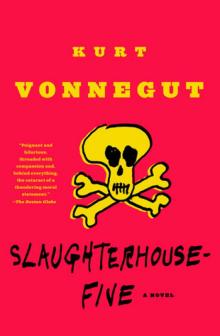 Slaughterhouse-Five
Slaughterhouse-Five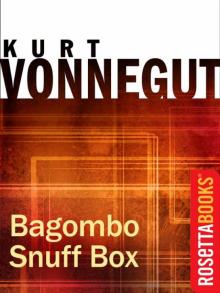 Bagombo Snuff Box: Uncollected Short Fiction
Bagombo Snuff Box: Uncollected Short Fiction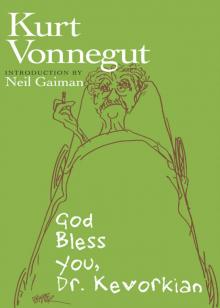 God Bless You, Dr. Kevorkian
God Bless You, Dr. Kevorkian Breakfast of Champions
Breakfast of Champions While Mortals Sleep: Unpublished Short Fiction
While Mortals Sleep: Unpublished Short Fiction Slapstick or Lonesome No More!
Slapstick or Lonesome No More! Cat's Cradle
Cat's Cradle The Sirens of Titan
The Sirens of Titan A Man Without a Country
A Man Without a Country Look at the Birdie: Unpublished Short Fiction
Look at the Birdie: Unpublished Short Fiction Bluebeard
Bluebeard Hocus Pocus
Hocus Pocus The Big Trip Up Yonder
The Big Trip Up Yonder Palm Sunday: An Autobiographical Collage
Palm Sunday: An Autobiographical Collage Jailbird
Jailbird Happy Birthday, Wanda June
Happy Birthday, Wanda June Welcome to the Monkey House
Welcome to the Monkey House Player Piano
Player Piano Fates Worse Than Death: An Autobiographical Collage
Fates Worse Than Death: An Autobiographical Collage Love, Kurt
Love, Kurt Timequake
Timequake God Bless You, Mr. Rosewater
God Bless You, Mr. Rosewater 2 B R 0 2 B
2 B R 0 2 B The Eden Express: A Memoir of Insanity
The Eden Express: A Memoir of Insanity Mother Night
Mother Night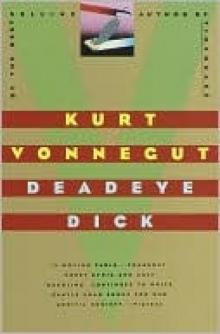 Deadeye Dick
Deadeye Dick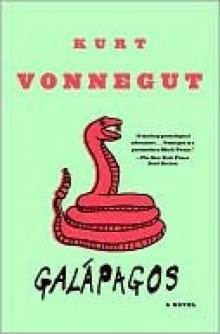 Galápagos
Galápagos Palm Sunday
Palm Sunday We Are What We Pretend to Be
We Are What We Pretend to Be Look at the Birdie
Look at the Birdie Basic Training
Basic Training Armageddon in Retrospect
Armageddon in Retrospect Basic Training (Kindle Single)
Basic Training (Kindle Single) If This Isn't Nice, What Is?
If This Isn't Nice, What Is? Bagombo Snuff Box
Bagombo Snuff Box The Petrified Ants
The Petrified Ants Cat's Cradle: A Novel
Cat's Cradle: A Novel Fates Worse Than Death: An Autobiographical Collage (Kurt Vonnegut Series)
Fates Worse Than Death: An Autobiographical Collage (Kurt Vonnegut Series)